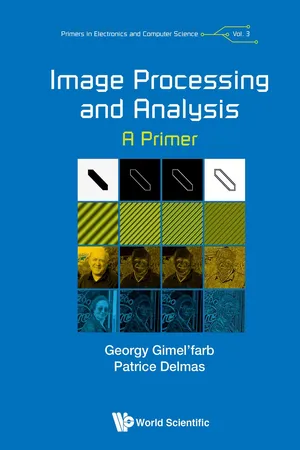
- 248 pages
- English
- ePUB (mobile friendly)
- Available on iOS & Android
About this book
This textbook guides readers through their first steps into the challenging world of mimicking human vision with computational tools and techniques pertaining to the field of image processing and analysis. While today's theoretical and applied processing and analysis of images meet with challenging and complex problems, this primer is confined to a much simpler, albeit critical, collection of image-to-image transformations, including image normalisation, enhancement, and filtering.
It serves as an introduction to beginners, a refresher for undergraduate and graduate students, as well as engineers and computer scientists confronted with a problem to solve in computer vision. The book covers basic image processing/computer vision pipeline techniques, which are widely used in today's computer vision, computer graphics, and image processing, giving the readers enough knowledge to successfully tackle a wide range of applied problems.
Contents:
- Preface
- About the Authors
- Continuous and Digital Images
- Transforming Appearance
- Filtering to Denoise or Enhance
- Filtering to Segment
- Morphological Filtering
- Deforming Boundaries to Segment
- Filtering to Find Points-of-Interest
- Transforming Image Plane
- Spectra and Spectral Filtering
- Appendices:
- Further Reading
- Symbols and Math Notation
- Abbreviations
- Bibliography
- Index
Readership: Advanced undergraduates and graduate students in science, engineering, environmental science, life sciences/biology and medicine. Engineers and scientists in need of a refresher or an introduction to image processing/computer vision.
Key Features:
- Written for beginners as introduction to image processing covering noices filtering, segmentation, and image transformation
- Supported with a wide range of case examples, demonstrate how computer pipeline techniques are used to solve the problems
Frequently asked questions
- Essential is ideal for learners and professionals who enjoy exploring a wide range of subjects. Access the Essential Library with 800,000+ trusted titles and best-sellers across business, personal growth, and the humanities. Includes unlimited reading time and Standard Read Aloud voice.
- Complete: Perfect for advanced learners and researchers needing full, unrestricted access. Unlock 1.4M+ books across hundreds of subjects, including academic and specialized titles. The Complete Plan also includes advanced features like Premium Read Aloud and Research Assistant.
Please note we cannot support devices running on iOS 13 and Android 7 or earlier. Learn more about using the app.
Information
Chapter 1
Continuous and Digital Images

Table of contents
- Cover
- Halftitle
- Series Editor
- Title
- Copyright
- Preface
- About the Authors
- Contents
- 1. Continuous and Digital Images
- 2. Transforming Appearance
- 3. Filtering to Denoise or Enhance
- 4. Filtering to Segment
- 5. Morphological Filtering
- 6. Deforming Boundaries to Segment
- 7. Filtering to Find Points-of-Interest
- 8. Transforming Image Plane
- 9. Spectra and Spectral Filtering
- Appendix A Further Reading
- Appendix B Symbols and Math Notation
- Appendix C Abbreviations
- Bibliography
- Index